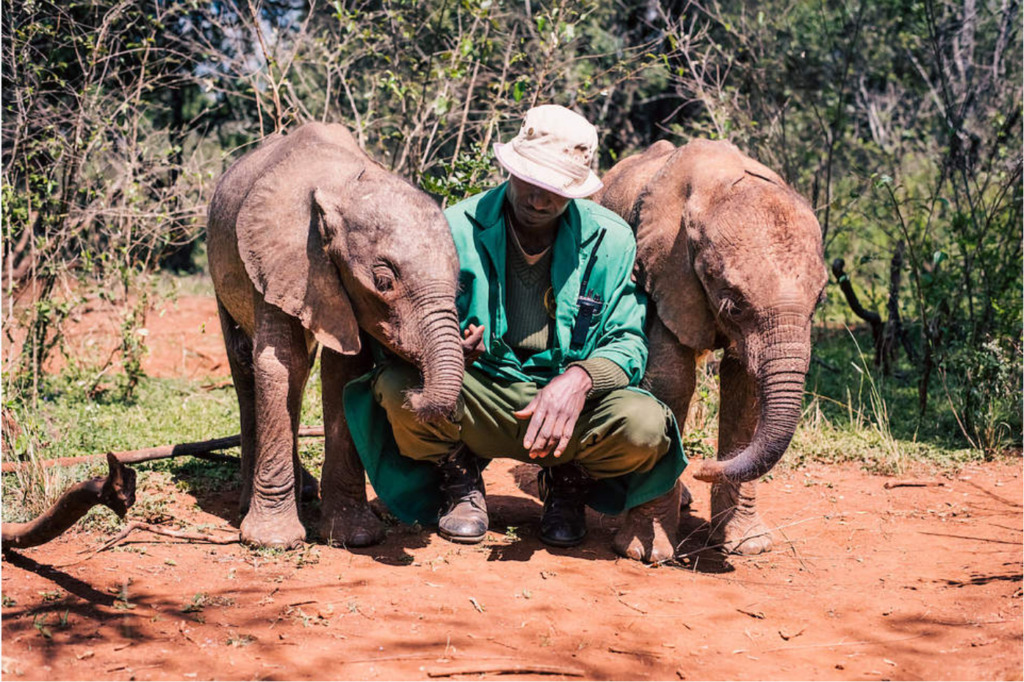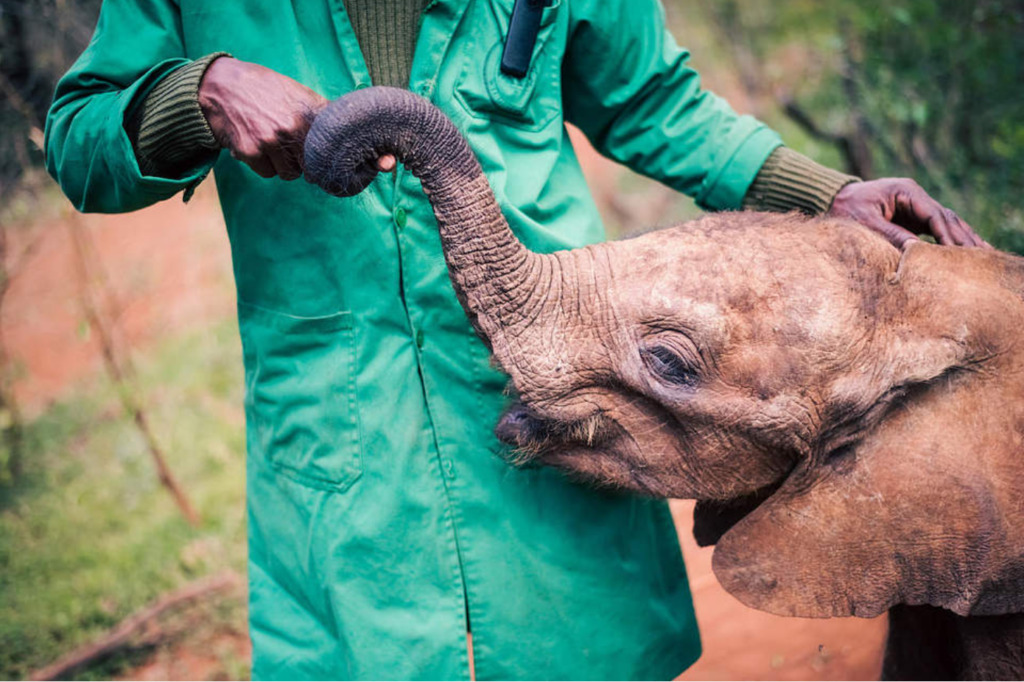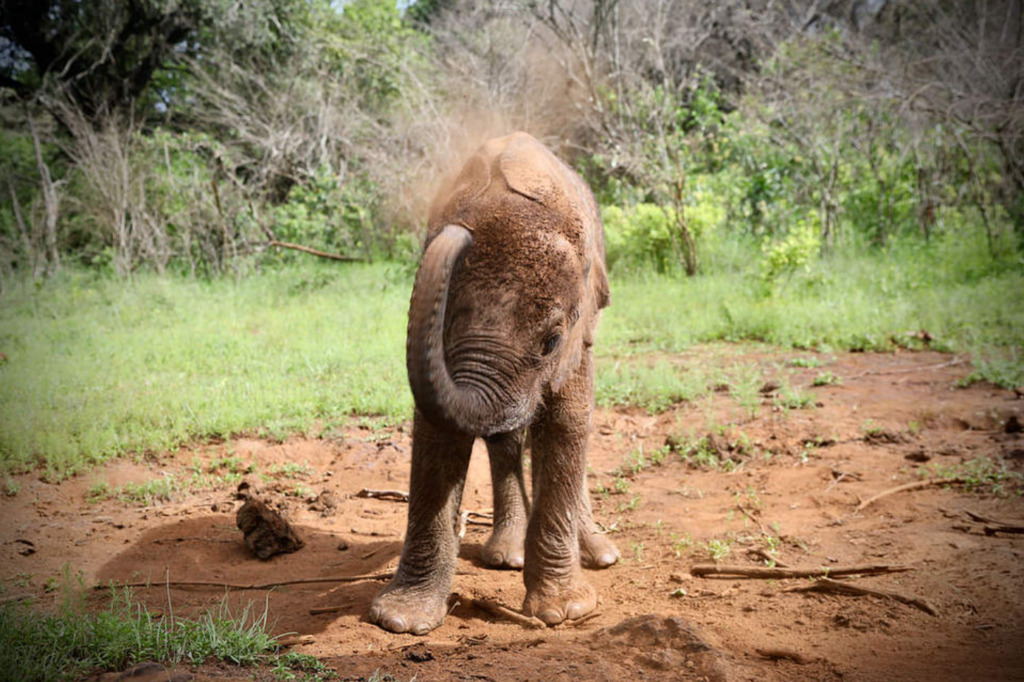In a serene wildlife sanctuary, as the sun cast a warm, golden glow, an enchanting scene unfolded. Amidst the peaceful backdrop, a unique melody pierced the quietude. It was dinnertime, and a gentle giant decided to cue its caretaker with a whimsical trunk serenade.
As the caretaker was enveloped in the gentle embrace of a midday slumber, the hungry elephant decided it was time to stir him. With a playful heart and an empty stomach, it approached its human companion, its trunk swaying gently with a rhythmic grace, creating a visual and auditory spectacle reminiscent of a gentle wind chime.
Rather than disrupting the tranquility with impatient demands, this majestic creature chose a tender, playful serenade to communicate its hunger. Its trunk, a marvel of nature, softly caressed the caretaker, tapping rhythmically, creating a melody that was as charming as it was unexpected.
The caretaker, initially taken aback by this unusual wake-up call, soon tuned into the elephant’s gentle rhythm, understanding the sweet request behind the melodious taps. His heart warmed as he awoke, the unique bond between them evident in this silent conversation.

This whimsical exchange transcended the barriers of language, painting a vivid picture of the profound understanding that can blossom between the hearts of different species. It showcased not merely a moment of hunger, but a beautiful ballet of trust, care, and respect that had bloomed over years of companionship.
The story is a poignant reminder of the extraordinary relationships that can foster in the heart of nature, between beings of different kinds. The playful interaction underscores the emotional richness that exists within the animal kingdom, and the imperative to honor and preserve these magnificent creatures and their habitats.
Amidst a world where the clamor of discord often drowns the melodies of harmony, this tender tale serves as a heartwarming reminder. The playful serenade of a hungry elephant echoes the profound truth – that love, trust, and understanding resonate beyond words, beyond species, creating a melody that’s both endearing and enlightening.
As the caretaker arose to the gentle nudges, and the hungry elephant eagerly awaited its meal, their bond exemplified a beautiful chapter in the endless narrative of extraordinary human-animal connections. This narrative is not just a fleeting moment of whimsy, but a profound message of co-existence, echoing the essential symphony of life and companionship in the heart of the wild.
Unveiling the Friendly Nature of Elephants
Elephants, often dubbed as gentle giants, epitomize friendliness and sociability despite their colossal size. These magnificent creatures are known for their gentle demeanor and emotional intelligence, traits that mark them as one of the most amiable animals in the wild. The roots of their friendly nature can be traced back to various aspects of their behavior and inherent characteristics.
One significant aspect is their social structure. Elephants thrive in matriarchal herds led by an experienced female elephant, creating a nurturing environment that fosters social bonds and interactions. This cohesive structure within the herd cultivates a sense of community and mutual care. Their social disposition often extends beyond their herds, leading to friendly interactions with other species, including humans.
Renowned for their emotional intelligence, elephants are capable of expressing and perceiving a wide range of emotions such as joy, sadness, and empathy. Their ability to empathize with the emotions of fellow elephants and other animals facilitates compassionate and friendly interactions, making them approachable beings in the wilderness.
Communication is another forte of elephants. They possess an intricate system of communication involving vocalizations, body language, and chemical signaling. This elaborate communication system allows them to convey their intentions and emotions effectively, often leading to gentle and friendly interactions with others around them.

Their exceptional memory, recognized for its ability to remember friends and foes alike, plays a pivotal role in forming long-term bonds with other animals and humans. The relationships fostered over time are a testament to their friendly relations and loyalty.
Despite their massive size, elephants exhibit a gentle and cautious disposition in their interactions to avoid causing harm. They show a remarkable level of gentleness and patience, especially with their young, further showcasing their friendly demeanor.
Curiosity, a trait inherent in elephants, often leads to playful and friendly interactions. Their playful and curious nature contributes significantly to their friendly demeanor, making encounters with them enchanting experiences.
Lastly, the long history of interaction between elephants and humans has often led to the formation of bonds with their caregivers. When treated with respect and kindness, elephants reciprocate with friendliness and loyalty, further exemplifying their gentle and friendly nature.
The amalgamation of these factors elucidates why elephants are revered as friendly and gentle beings. Their ability to forge friendships, comprehend, and exhibit compassion are profound reflections of the emotional depth and sociability inherent in elephants, marking them as truly remarkable members of the animal kingdom.
The Imperative to Protect Elephants
Elephants are not just iconic figures of the wild, but they play a pivotal role in maintaining ecological balance. Their preservation goes beyond a mere act of compassion; it is a necessity for a thriving ecosystem. Here’s an exploration into why protecting elephants is crucial:
Environmental Stewardship:
Elephants are often termed as ‘ecosystem engineers’ due to their ability to shape the environment around them. Through their feeding habits, they control and influence vegetation, ensuring a balanced ecosystem. They disperse seeds through their dung, facilitating the growth of flora, which in turn provides food and habitat for other wildlife. Additionally, their trampling of plants and uprooting of trees creates clearings that foster a mix of different vegetation types, promoting biodiversity.
Water Source Enablers:
In arid regions, elephants are known to dig water holes, aiding not just themselves but other animals in accessing water, especially during dry spells. Their role as water source enablers is vital in regions where water scarcity is a prominent issue.
Biodiversity Boosters:
The actions of elephants significantly contribute to biodiversity. By acting as seed dispersers, they aid in the germination and spread of plants, some of which are solely dependent on elephants for propagation. Their interactions with the environment foster a habitat conducive to the survival and thriving of various species.

Cultural and Economic Significance:
Elephants hold a rich cultural significance in many regions, symbolizing wisdom, strength, and royalty. They also contribute to the local economies through eco-tourism. Tourists flock to reserves and sanctuaries to witness these majestic creatures, thus generating revenue that often funds conservation efforts and supports local communities.
Human-Elephant Coexistence:
Learning to coexist with elephants and understanding their significance in ecosystems can lead to better conservation strategies. This coexistence is crucial to mitigate human-wildlife conflicts, which often result in fatalities on both sides.
Climate Change Mitigators:
Forests play a crucial role in sequestering carbon dioxide, and elephants, through their seed dispersal actions, contribute to forest regeneration. By aiding in maintaining healthy forest ecosystems, elephants play a part in combating climate change.
Research and Education:
Elephants are subjects of extensive scientific research, offering insights into their complex social structures, intelligence, and emotions. Understanding elephants better can lead to more effective conservation strategies and broader education on wildlife preservation.
The protection of elephants is not just an ethical duty but an ecological necessity. Their survival and well-being are intertwined with the health and sustainability of ecosystems. Ensuring their protection is a step towards preserving the delicate balance of nature, reinforcing the harmonious coexistence of varied life forms on our planet.
Conclusion
The captivating tales of friendly elephants and their endearing interactions unveil not just the emotional depth of these majestic creatures, but also the imperative of their preservation for ecological harmony. As we revel in the whimsical trunk serenades and gentle nudges, let us also heed the deeper call of the wild, a plea for understanding, respect, and proactive conservation to ensure the enduring melody of nature continues to enchant generations to come.